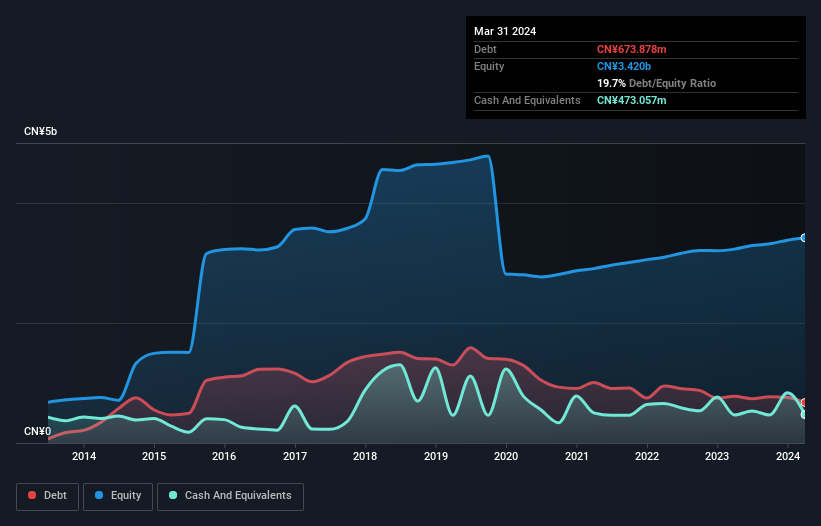Is Jiangsu Hoperun Software (SZSE:300339) A Risky Investment?

Some say volatility, rather than debt, is the best way to think about risk as an investor, but Warren Buffett famously said that 'Volatility is far from synonymous with risk.' It's only natural to consider a company's balance sheet when you examine how risky it is, since debt is often involved when a business collapses. As with many other companies Jiangsu Hoperun Software Co., Ltd. (SZSE:300339) makes use of debt. But the more important question is: how much risk is that debt creating?
When Is Debt A Problem?
Debt assists a business until the business has trouble paying it off, either with new capital or with free cash flow. Ultimately, if the company can't fulfill its legal obligations to repay debt, shareholders could walk away with nothing. However, a more common (but still painful) scenario is that it has to raise new equity capital at a low price, thus permanently diluting shareholders. Of course, the upside of debt is that it often represents cheap capital, especially when it replaces dilution in a company with the ability to reinvest at high rates of return. When we think about a company's use of debt, we first look at cash and debt together.
See our latest analysis for Jiangsu Hoperun Software
What Is Jiangsu Hoperun Software's Debt?
You can click the graphic below for the historical numbers, but it shows that Jiangsu Hoperun Software had CN¥673.9m of debt in March 2024, down from CN¥779.0m, one year before. However, it also had CN¥473.1m in cash, and so its net debt is CN¥200.8m.

How Strong Is Jiangsu Hoperun Software's Balance Sheet?
The latest balance sheet data shows that Jiangsu Hoperun Software had liabilities of CN¥1.14b due within a year, and liabilities of CN¥425.7m falling due after that. Offsetting this, it had CN¥473.1m in cash and CN¥1.85b in receivables that were due within 12 months. So it can boast CN¥751.8m more liquid assets than total liabilities.
This surplus suggests that Jiangsu Hoperun Software has a conservative balance sheet, and could probably eliminate its debt without much difficulty. Carrying virtually no net debt, Jiangsu Hoperun Software has a very light debt load indeed.
We use two main ratios to inform us about debt levels relative to earnings. The first is net debt divided by earnings before interest, tax, depreciation, and amortization (EBITDA), while the second is how many times its earnings before interest and tax (EBIT) covers its interest expense (or its interest cover, for short). Thus we consider debt relative to earnings both with and without depreciation and amortization expenses.
Jiangsu Hoperun Software has a low net debt to EBITDA ratio of only 1.5. And its EBIT easily covers its interest expense, being 11.9 times the size. So we're pretty relaxed about its super-conservative use of debt. Better yet, Jiangsu Hoperun Software grew its EBIT by 248% last year, which is an impressive improvement. That boost will make it even easier to pay down debt going forward. When analysing debt levels, the balance sheet is the obvious place to start. But ultimately the future profitability of the business will decide if Jiangsu Hoperun Software can strengthen its balance sheet over time. So if you're focused on the future you can check out this free report showing analyst profit forecasts.
Finally, a business needs free cash flow to pay off debt; accounting profits just don't cut it. So we clearly need to look at whether that EBIT is leading to corresponding free cash flow. Looking at the most recent three years, Jiangsu Hoperun Software recorded free cash flow of 28% of its EBIT, which is weaker than we'd expect. That weak cash conversion makes it more difficult to handle indebtedness.
Our View
Jiangsu Hoperun Software's EBIT growth rate suggests it can handle its debt as easily as Cristiano Ronaldo could score a goal against an under 14's goalkeeper. But truth be told we feel its conversion of EBIT to free cash flow does undermine this impression a bit. Zooming out, Jiangsu Hoperun Software seems to use debt quite reasonably; and that gets the nod from us. While debt does bring risk, when used wisely it can also bring a higher return on equity. There's no doubt that we learn most about debt from the balance sheet. But ultimately, every company can contain risks that exist outside of the balance sheet. Be aware that Jiangsu Hoperun Software is showing 1 warning sign in our investment analysis , you should know about...
When all is said and done, sometimes its easier to focus on companies that don't even need debt. Readers can access a list of growth stocks with zero net debt 100% free, right now.
New: Manage All Your Stock Portfolios in One Place
We've created the ultimate portfolio companion for stock investors, and it's free.
• Connect an unlimited number of Portfolios and see your total in one currency
• Be alerted to new Warning Signs or Risks via email or mobile
• Track the Fair Value of your stocks
Have feedback on this article? Concerned about the content? Get in touch with us directly. Alternatively, email editorial-team (at) simplywallst.com.
This article by Simply Wall St is general in nature. We provide commentary based on historical data and analyst forecasts only using an unbiased methodology and our articles are not intended to be financial advice. It does not constitute a recommendation to buy or sell any stock, and does not take account of your objectives, or your financial situation. We aim to bring you long-term focused analysis driven by fundamental data. Note that our analysis may not factor in the latest price-sensitive company announcements or qualitative material. Simply Wall St has no position in any stocks mentioned.
About SZSE:300339
Jiangsu Hoperun Software
Operates as a software company that provides products, solutions, and services based on new generation information technology in China, Japan, Southeast Asia, North America, and internationally.
Excellent balance sheet with questionable track record.
Market Insights
Community Narratives


